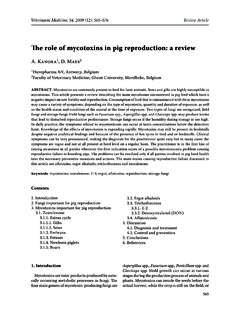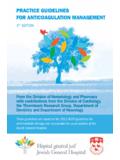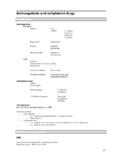Transcription of Heparin and its derivatives in the treatment of …
1 Veterinarni Medicina, 55, 2010 (11): 523 546 Review Article523 Heparin and its derivatives in the treatment of arterial thrombosis: a reviewM. Dvorak1, M. Vlasin2, M. Dvorakova3, P. Rauser2, L. Lexmaulova2, Z. Gregor1, R. Staffa112nd Department of Surgery, St. Anne s University Hospital, Faculty of Medicine, Masaryk University, Brno, Czech Republic2 Faculty of Veterinary Medicine, University of Veterinary and Pharmaceutical Sciences, Brno, Czech Republic3 Department of Internal Medicine, Hematology and Oncology, University Hospital Brno and Faculty of Medicine, Masaryk University, Brno, Czech RepublicABSTRACT: Arterial occlusion due to thrombosis caused by ruptured atherosclerotic plaques (Baba et al.)
2 , 1975) has been recognized as a major cause of morbidity and mortality in western populations. Thrombosis may occur in various sections of arterial circulation, peripheral arteries of the limbs, coronary arteries, brain arteries, or both major and minor vessels within the abdominal cavity. The ultimate consequence is varying degrees of organ failure, mostly of ischemic origin. Arterial thrombosis represents a continuous problem, debilitating patients and decreasing their quality of life. Moreover, along with chronic heart failure, it can significantly decrease patient life expectancy. Arterial thrombosis results in ischemia, with serious systemic consequences, such as metabolic breakdown.
3 The major goal of treatment remains fast and efficient recanalization surgical, interventional or thrombolytic. To be able to prevent acute reocclusion with severe consequences (rhabdomyolysis, compartment syndrome, excessive tissue necrosis leading to limb amputation, etc.), several adjunctive treatment regimens have been advocated. Among others, thrombin inhibitors and platelet inhibitors have been widely used for both prophylaxis and adjunctive treatment . Direct thrombin inhibitors and antithrombin stimulators have been recognized as typical antithrombotic drugs. Direct (antithrombin-independent) thrombin inhibitors can be divided into two main categories: monovalent, active site inhibitors (argatroban, efegatran, inovastan, melagatran) and bivalent (hirudin, hirugen, hirulog, bivalirudin), while antithrombin stimulators represent standard (unfractionated) Heparin (UFH) and its depolymerizing products low molecular weight heparins (LMWH s).
4 Recently, a clear change in the main use of Heparin , as well as low-molecular weight heparins has been advocated representing a shift from treatment and prophylaxis of deep vein thrombosis to prophylaxis of thromboembolic disease following vascular, cardiovascular or orthopedic surgery, treatment of unstable angina and prevention of acute myocardial infarction. The main effect of heparins lies in their anticoagulant activity. Heparins are involved in different pathways of the coagulation cascade with anticoagulant, antithrombotic, profibrinolytic, anti-aggregative, as well as anti-inflammatory effects. Moreover, there is a little doubt about their anti-proliferative and anti-ischemic activity (Penka and Bulikova, 2006).
5 Unlike standard Heparin , low-molecular weight heparins do not affect the patient s general coagulation profile. Obviously, the difference in molecular weight results in different pharmacokinetic and pharmacodynamic properties of the words: coagulation; arterial thrombosis; standard Heparin ; low-molecular weight heparinsList of abbreviationsABI = axillary/..index, t-PA = tissue-type plasminogen activator, ADP = adenosin diphosphate, AG = angiography, AMI = acute myocardial infarction, APSAC = acylated plasminogen streptokinase activator complex, APTT = activated partial thromboplastin time, AS = acute stroke, AT = antithrombin, AT D = acute thromboembolic disease, CNS = central nervous system, DNA = deoxyribonucleic acid, DSA = digital subtractional angiography, DVT = deep vein thrombosis, FDP s = fibrin fibrinogen degradation products, HCII = Heparin cofactor II, HIT = Review Article Veterinarni Medicina, 55, 2010 (11): 523 5465241.
6 Atherosclerosis as the main cause of thrombosisOcclusion of peripheral vessels is in more than 90% of cases caused by atherosclerosis leading to throm-bosis. Chronic vasculitis, small aneurysms, acute embolic disease, or external compression of arter-ies is observed less frequently. Atherosclerosis can affect arteries of the lower limbs, carotid arteries, brain arteries and, last but not least, coronary arteries (Ferrieres et al., 2006). On the other hand, upper limb arteries are only affected in extremely rare development of atherosclerosis is rather long and without clinical signs. Atherosclerotic plaques can subsequently obstruct the blood stream within the vessel by narrowing its diameter.
7 According to the vessels affected, clinical consequences may in-clude: ischemic heart failure (IHF), ischemic stroke (IS), or peripheral thromboembolic disease, most frequently lower limb ischemic disease (LLID), ca-rotid and/or renal artery can be defined as a degenerative process, typically with inflammatory infiltration of the vessel wall, accumulation of triglycerides and proliferation of fibrotic tissue. The early stage of atherosclerosis is more or less characterized by penetration of atherogenic lipoproteins and inflammatory cells through the endothelial layer and their accumulation in the sub-endothelial space. Later on, fibro-proliferative and degenera-tive processes take place, as a reaction to high levels of lipoproteins and inflammatory mediators.
8 The development of atherosclerotic plaques currently depends on the effect of atherogenic lipoproteins in combination with endothelial damage and local inflammatory thrombocytopenia, IHF = ischemic heart failure, LDL = low density lipoproteins, LLID = lower limb ischemic disease, LMWH = low-molecular weight Heparin , LMWH s = low-molecular weight heparins, MRA = magnetic resonance angiography, PAT = percutaneous aspiration thrombectomy, PDGF = platelet-derived growth factor, P TA = percutaneous transluminal angioplasty, PTCA = percutaneous transluminal coronary angioplasty, SCu-PA = single chain urokinase-type plasminogen activator, TFPI = tissue factor pathway inhibitor, UFH = unfractionated Heparin , USG = ultrasonography, V S M C s = vascular smooth muscle cellsContents1.
9 Atherosclerosis as the main cause of thrombosis2. Arterial thrombosis of lower Definition and pathogenesis of arterial Etiology of an acute arterial thrombosis, Virchow s Clinical Diagnostic protocol for patients with sus-pected acute peripheral treatment options for acute peripheral Surgical Interventional endovascular First generation thrombolytic Second generation thrombo-lytic agents3. Effect of Heparin on the coagulation Limitations of Pharmacokinetics of Monitoring of treatment by Antidotes of Effect of Heparin on vascular smooth muscle cell Indications of Side-effects of Heparin -induced thrombocytopenia Osteoporosis4.
10 Low molecular weight heparins LMWH Anticoagulation properties of LMWH Pharmacokinetics of LMWH Efficacy and safety of LMWH s in an animal LMWH s in the prevention of arterial throm-bosis clinical Administration and monitoring of LMWH s5. Summary6. Conclusions7. ReferencesVeterinarni Medicina, 55, 2010 (11): 523 546 Review Article525 Based on pathophysiology, three main stages of atherosclerosis are described: (1) early lesions with fatty stripes, (2) fibrotic and atherosclerotic plaques, (3) stage of complication development (Hansson et al., 2002). To be able to control athero-sclerosis, one must pay due attention to so called risk factors . Risk factors are recognized as reduc-ible and non-reducible.












